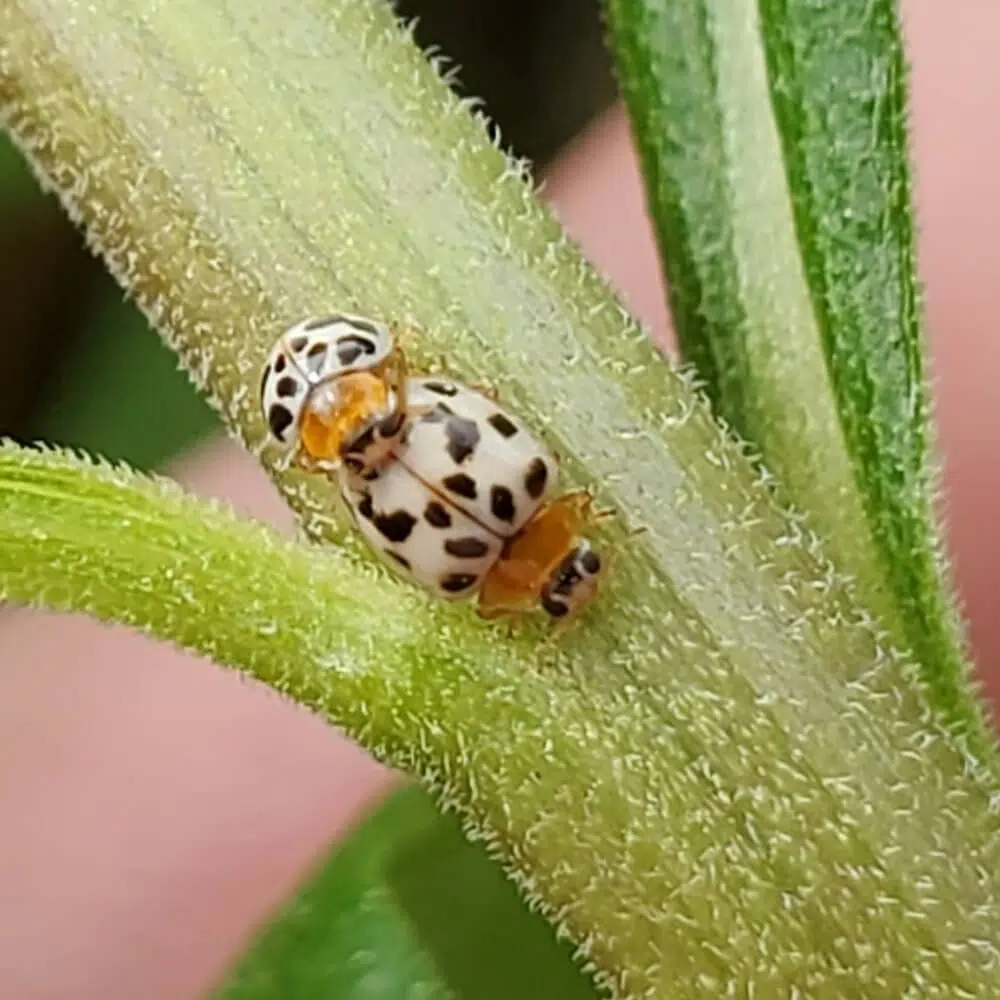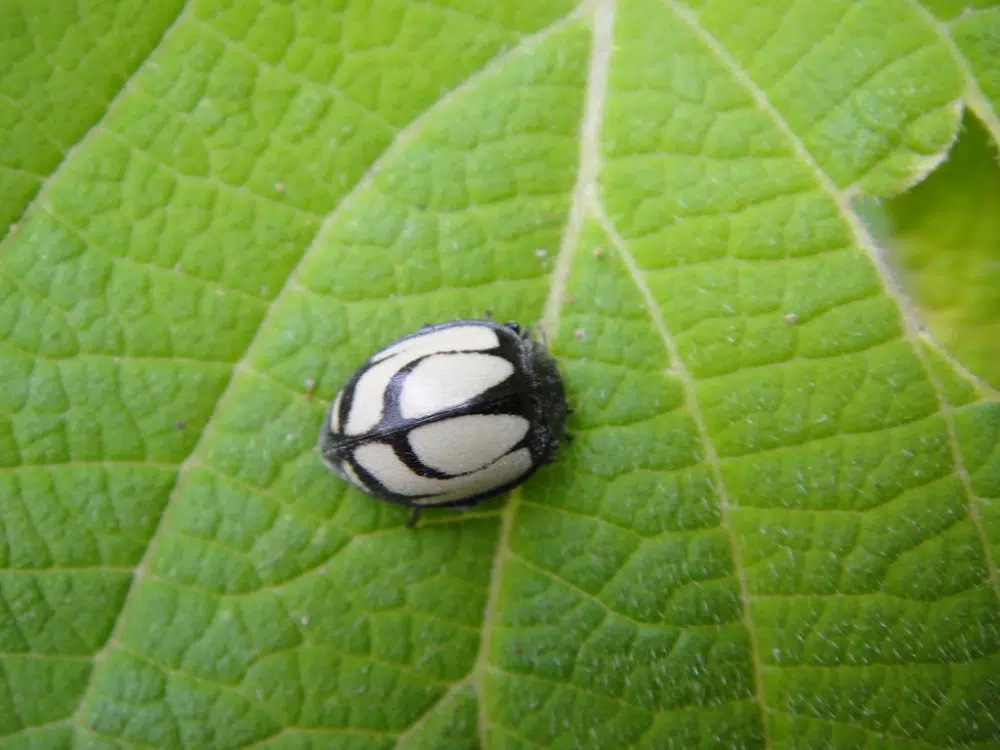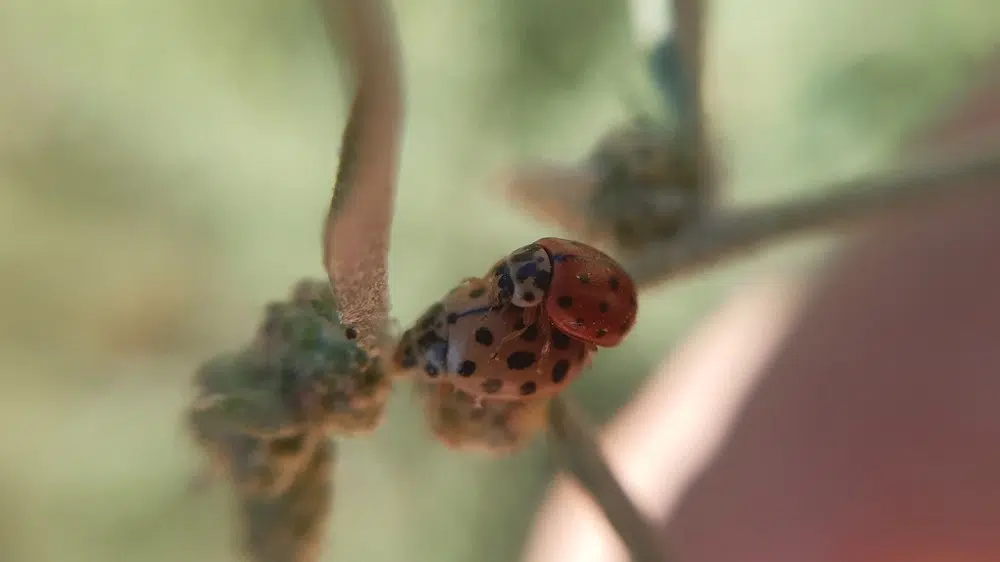Ladybugs are often associated with red and black colors. Red elytra with black spots are the most common ladybug representation in the media.
White ladybugs with black spots are rare or not as common as their red and black counterparts. There are multiple species of white ladybugs with black spots in the US. Some are native while others are imported.
These white bugs share many traits with red ladybugs such as size, diet, and habitat.
Table of Contents
Are There White Ladybugs With Black Spots?
There are multiple species of white ladybugs in North America, South America, Europe, and around the world.
Ash Gray Lady Beetles and Twenty-Spotted Lady Beetles are some of the most common white ladybugs with black spots in North America.
These white bugs are either known for eating mildew or for eating invasive bugs such as aphids.
Types of White Ladybugs with Black Spots
The following species of ladybugs are either white with black spots in general or they come in a white morph.
1. Ashy Gray Lady Beetle

Ash Gray Lady Beetles (Olla v-nigrum) have a white or black main color. The white morph has an off-white or white-gray color with black spots on the elytra and the head.
These small dark spots and the bright color are opposite to its black morph that exhibits large red spots on the elytra.
Known as beneficial for gardens, Ash Gray Lady Beetles eat invasive bugs. Females of the species lay yellow eggs.
These eggs hatch into black and yellow larvae. The coloring of the larvae isn’t similar to the coloring of the adult Ash Gray Lady Beetle.
2. Twenty-spotted Lady Beetle

The Twenty-spotted Lady Beetle (Psyllobora vigintimaculata) has a white head, a white pronotum, and white elytra. This specie shows black spots all across these main body parts.
Native to North America, the Twenty-spotted Lady Beetle is found in all states but it’s absent from Florida.
The Twenty-spotted Lady Beetle might be white with orange spots in some states.
The lady beetle feeds on mildew and it’s found on plants and crops affected by mildew.
Small Twenty-spotted Lady Beetles are very picky about their food and they do not eat anything else apart from mildew.
3. Fifteen-spotted Lady Beetle

The Fifteen-spotted Lady Beetle (Anatis labiculata) has white elytra with black spots. Its pronotum is white. It has an M-shaped black mark while the head is white with black marks.
These bugs have orange legs and orange elytra margins.
Fifteen-spotted Lady Beetles are native to North America.
They live in places where they can find small bugs to feed on.
Bugs Fifteen-spotted Lady Beetles feed on include aphids and mites, but they also eat other types of smaller bugs.
4. Psyllobora picta

Native to South America, this species is beginning to be seen in large numbers across North America.
It represents a type of white ladybug with black spots that don’t feed on aphids. Psyllobora picta eats mildew and it lives on plants with mildew.
This ladybug has a white head with large black marks and white elytra with similar irregular-shaped black marks.
The species has yellow-orange legs and yellow-orange antennae.
5. Psyllobora bicongregata

This species of ladybugs are known for its off-white color with brown and black marks.
It has a completely white body but its dark spots are a combination of brown and black segments.
These ladybugs darken with age. Their body becomes cream, light brown, to finally settle to a dark brown color.
Ladybugs of this genus have been imported from South America.
6. Globe-marked Lady Beetle

Globe-marked Lady Beetles (Azya orbigera) have a white fuzzy appearance with black undertones and 2 large black spots on the elytra.
These ladybugs have white larvae and they feed on mildew.
Bugs of this genus grow to a maximum size of 3-5mm.
7. Small-spotted Fairy Lady Beetle

This species (Psyllobora parvinotata) has a completely white body with black spots. In some cases, its head can be orange-brown instead of the more common white color.
Bugs of this genus grow to a maximum size of 3mm. They are common in Southeastern US.
Large Small-spotted Fairy Lady Beetle populations are found in Florida.
8. Azya luteipes

These white ladybugs are common on sweet orange leaves. They can eat aphids and they have been used against all series of bug pests on coffee.
These ladybugs have a white body with black spots or a brown body with 2 black spots on the elytra.
Native to South America, the bugs have been imported all around the world.
9. Epilachna nigrocincta

These ladybugs can have a white, red, or brown elytra with black margins and black central lines.
Epilachna nigrocinta are native to Central and South America where they are considered a beneficial species.
They feed on plant mildew.
10. Bulaea lichatschovi

Native to Southern Europe, this ladybug species has a white or cream color with black spots and black marks on its head.
The species has tan spots on the pronotum, a large black spot on the head, and multiple smaller black spots on the elytra.
These bugs also exhibit black a black central elytra stripe.
Its legs are yellow-brown or tan.
Do Black and White Ladybugs Bite?
Black and white ladybugs don’t bite. They cannot pierce human skin and they do not willingly bite people. When carnivorous, these bugs only eat aphids, plant mites, and other small bugs on plants.
Black and white ladybugs can also eat mildew.
Many white ladybugs with black spots are beneficial in gardens as they eat invasive aphids that can kill plants, herbs, and vegetables.
Some ladybugs may bite, but these are rare cases.
Even those bitten by these bugs rarely feel anything since ladybugs don’t have sharp mouthparts. They only have a small mouth they can sometimes use to capture very small bugs and mites.
Are Black and White Ladybugs Poisonous?
Black and white ladybugs aren’t poisonous.
Contrasting elytra colors and the addition of spots make them seem poisonous or venomous to potential predators. These bugs have a bad sour taste, but they aren’t poisonous.
Black and white ladybugs eat aphids which aren’t poisonous either.
A musky smell coming from a secretion of these bugs can make predators such as birds think these bugs are poisonous.
There are data to suggest the more colorful ladybugs are more poisonous compared to pale or white ladybugs.
As a result, white and ladybugs with spots don’t have the same level of musky bad taste as red or yellow ladybugs.
Spiritual Meanings of White Ladybugs with Black Spots
White and black ladybugs are so rare that simply seeing them is a special event. Those guiding themselves by the spiritual meaning of these ladybugs normally write down the day they saw them and analyze events as they unfold.
There are multiple meanings to white, and black, as well as to the combination of these colors in various cultures around the world.
Purity
White symbolizes purity. It’s the essential interpretation of a pure person or a pure idea. Seeing a white ladybug with black spots might be a sign you’re about to meet a pure person or that you are a pure person.
Some believe seeing one of these ladybugs also symbolizes your need to make your life pure. Switching to healthy habits and solid relationships with those around you might be all interpretations of purity.
You can also help your children or spouse live a pure life whenever you see one of these black ladybugs. Helping partners is one of the essential characteristics of contrasting black and white colors these bugs symbolize as both are a side to the same coin.
Prosperity
Feelings of prosperity are also tied to these white ladybugs with black spots. White has been used in the form of clothing by wealthy people in the past.
They were the only ones who were afforded to wear purely white clothes as they had servants to wash and maintain these clothes purely white.
Prosperity comes in many forms and seeing white ladybugs can be an indication you may encounter prosperity or that you might need to seek prosperity.
A prosperous life is seen as a complete life in many cultures. Prosperous people have the resources to help others which goes back to the idea of purity and idealism white color is often associated with.
Fertility
White is also one of the colors associated with fertility. White clothes are worn by pregnant women and by newborn children.
A fertile woman is considered a worthy woman in many cultures. Fertility itself is celebrated as the most important gift in life in many cultures.
A white ladybug can be a sign of fertile fortunes coming your way. This can also apply to a man who expects children or men who want more children.
Fertility is often tied to protection, especially when it comes to the love of a mother. This symbolism is tied to white and to ladybugs, which are seen as friendly bugs.
Harmony
Harmony is the most important symbolism in white and black ladybugs. Ying and Yang are the perfect juxtapositions when it comes to harmony.
Black and white good and bad lived together for as long as humans exist. Good and bad forces shape our lives and guide us through our relationships and actions.
White and black ladybugs also symbolize the dual nature of humanity. We can be good or bad or even both at the same time depending on how we look at ourselves.
Seeing a white ladybug with black spots is seen as a good opportunity to analyze both our good and our bad parts. People are advised to take this as an opportunity for introspection and to see the forces that guide us in life.
From here, people can improve their lives and their actions accordingly. It’s only by recognizing both our strengths and our weaknesses that we can truly live a balanced life.
Not what things seem
The idea of Ying and Yang that’s often tied to white and black ladybugs can also be interpreted as the meaning of things that aren’t what they seem.
You can see a single face of a coin and think of it one way or see both of its faces for what it truly represents.
This idea has been tied to black and white bugs which may represent an action or a person that is not what you think it is. This is why introspection from the perspective of realism is recommended for your life when you see these bugs.
Both male and female nature can be found in this juxtaposition. Couples might need to take a better look at the male-female dynamics in the relationship whenever they see black and white ladybugs.
Male and female energy can work together, but only by following their strengths without trying to change each other but rather by understanding each other.
The idea of harmony is present in all interpretations of black and white ladybugs through the opposing nature of these colors.
Summary
White ladybugs with black spots are found in North America and around the world. These bugs are rare and some people are completely unaware of their existence.
They share some of the traits red and black ladybugs have such as eating aphids or being seen as a positive presence in gardens where they might control other bug pests.
White ladybugs are a rare sight that sometimes makes people believe in a special symbolism.
Harmony, purity, and fertility are just a few of the meanings people tie to seeing these white and black ladybugs.
Like red or orange ladybugs, white ladybugs are seen as friendly cheerful bugs according to their interpretation in media and culture.
Ladybugs, in general, as seen as a bug that brings good luck.
This rare symbolism is rarely tied to other bugs which are most likely seen as invasive, dirty, or even a sign of bad luck according to some cultures as opposed to ladybugs.